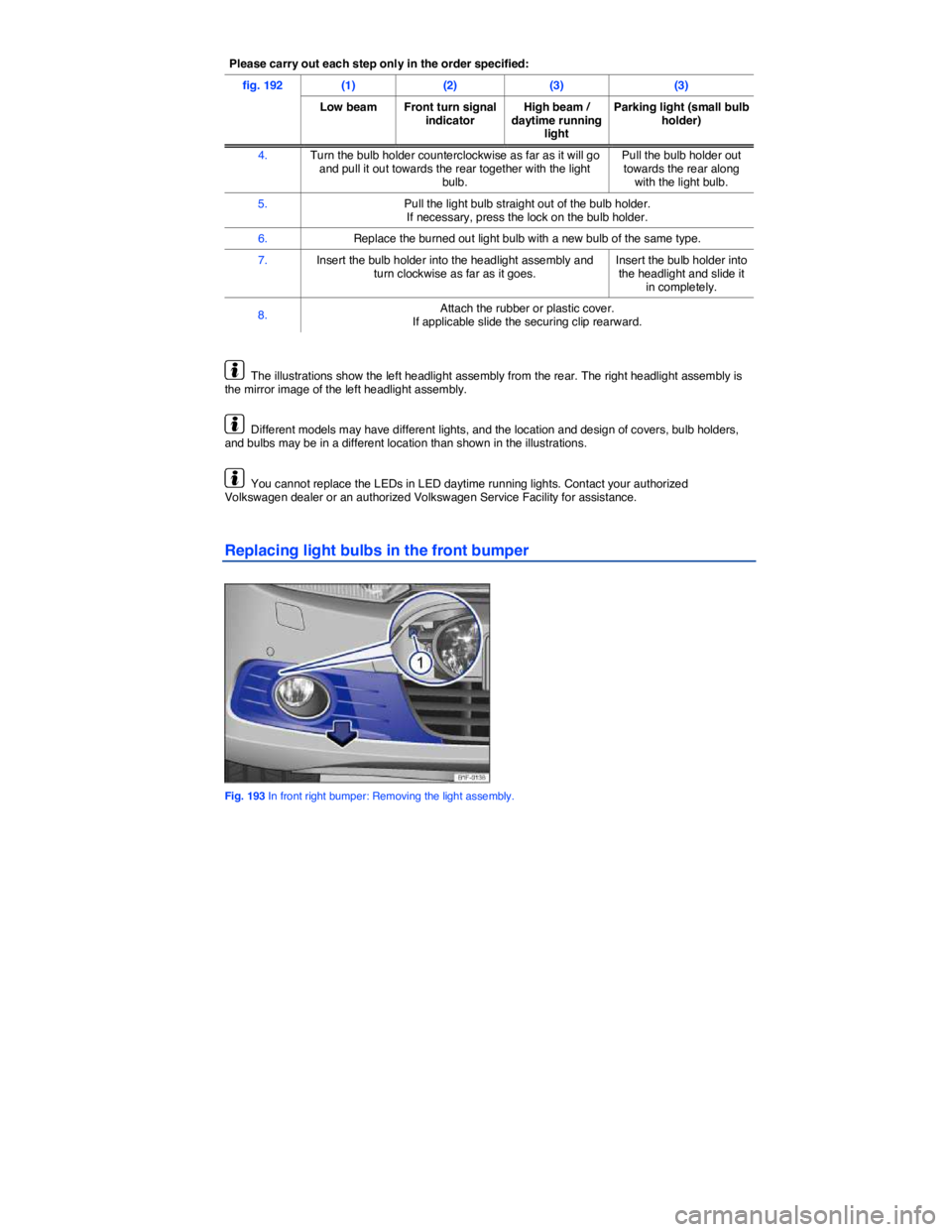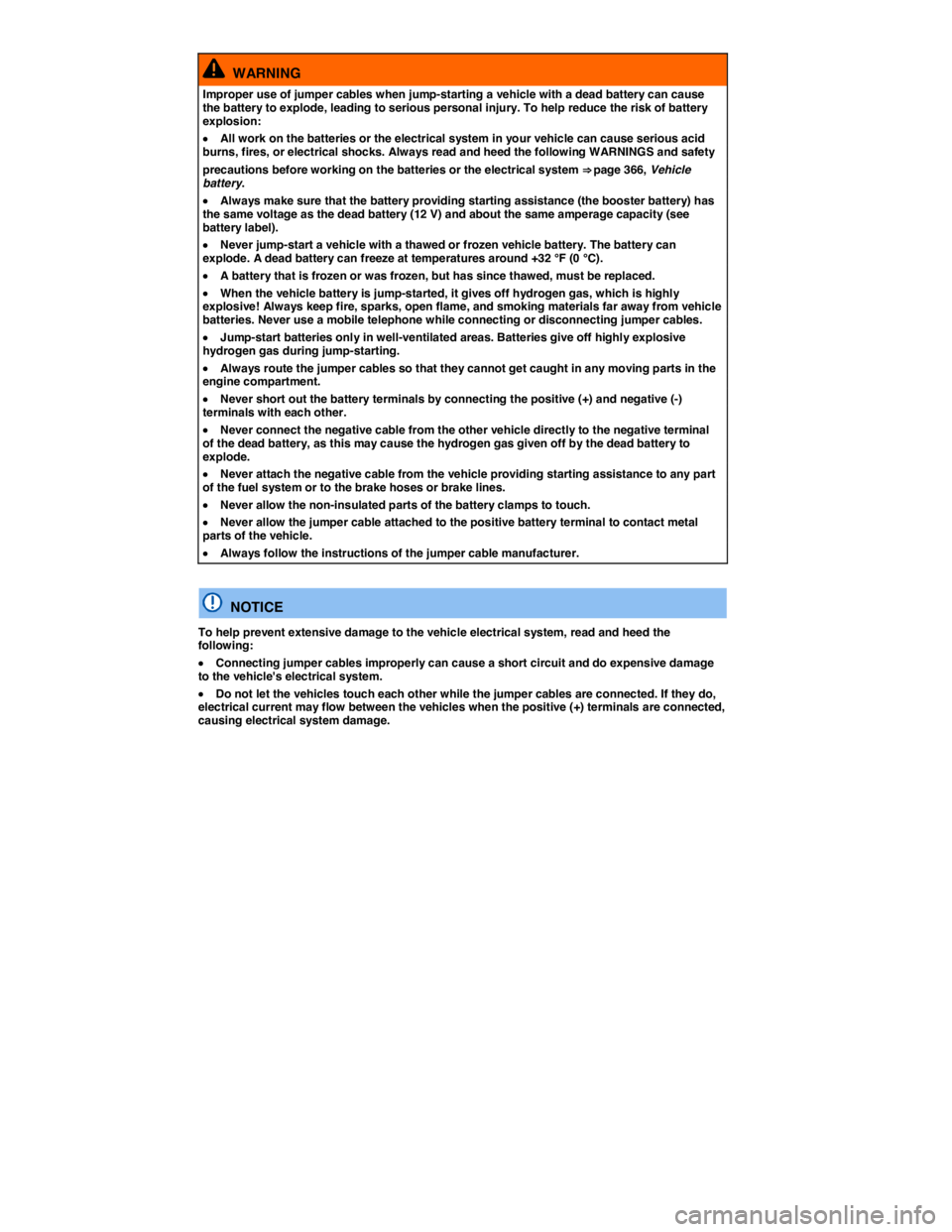Page 366 of 381

Please carry out each step only in the order specified:
fig. 192 (1) (2) (3) (3)
Low beam Front turn signal indicator High beam/ daytime running light
Parking light (small bulb holder)
4. Turn the bulb holder counterclockwise as far as it will go and pull it out towards the rear together with the light bulb.
Pull the bulb holder out towards the rear along with the light bulb.
5. Pull the light bulb straight out of the bulb holder. If necessary, press the lock on the bulb holder.
6. Replace the burned out light bulb with a new bulb of the same type.
7. Insert the bulb holder into the headlight assembly and turn clockwise as far as it goes. Insert the bulb holder into the headlight and slide it in completely.
8. Attach the rubber or plastic cover. If applicable slide the securing clip rearward.
The illustrations show the left headlight assembly from the rear. The right headlight assembly is the mirror image of the left headlight assembly.
Different models may have different lights, and the location and design of covers, bulb holders, and bulbs may be in a different location than shown in the illustrations.
You cannot replace the LEDs in LED daytime running lights. Contact your authorized Volkswagen dealer or an authorized Volkswagen Service Facility for assistance.
Replacing light bulbs in the front bumper
Fig. 193 In front right bumper: Removing the light assembly.
Page 371 of 381

WARNING
Improper use of jumper cables when jump-starting a vehicle with a dead battery can cause the battery to explode, leading to serious personal injury. To help reduce the risk of battery explosion:
�x All work on the batteries or the electrical system in your vehicle can cause serious acid burns, fires, or electrical shocks. Always read and heed the following WARNINGS and safety
precautions before working on the batteries or the electrical system ⇒ page 366, Vehicle battery.
�x Always make sure that the battery providing starting assistance (the booster battery) has the same voltage as the dead battery (12 V) and about the same amperage capacity (see battery label).
�x Never jump-start a vehicle with a thawed or frozen vehicle battery. The battery can explode. A dead battery can freeze at temperatures around +32 °F (0 °C).
�x A battery that is frozen or was frozen, but has since thawed, must be replaced.
�x When the vehicle battery is jump-started, it gives off hydrogen gas, which is highly explosive! Always keep fire, sparks, open flame, and smoking materials far away from vehicle batteries. Never use a mobile telephone while connecting or disconnecting jumper cables.
�x Jump-start batteries only in well-ventilated areas. Batteries give off highly explosive hydrogen gas during jump-starting.
�x Always route the jumper cables so that they cannot get caught in any moving parts in the engine compartment.
�x Never short out the battery terminals by connecting the positive (+) and negative (-) terminals with each other.
�x Never connect the negative cable from the other vehicle directly to the negative terminal of the dead battery, as this may cause the hydrogen gas given off by the dead battery to explode.
�x Never attach the negative cable from the vehicle providing starting assistance to any part of the fuel system or to the brake hoses or brake lines.
�x Never allow the non-insulated parts of the battery clamps to touch.
�x Never allow the jumper cable attached to the positive battery terminal to contact metal parts of the vehicle.
�x Always follow the instructions of the jumper cable manufacturer.
NOTICE
To help prevent extensive damage to the vehicle electrical system, read and heed the following:
�x Connecting jumper cables improperly can cause a short circuit and do expensive damage to the vehicle's electrical system.
�x Do not let the vehicles touch each other while the jumper cables are connected. If they do, electrical current may flow between the vehicles when the positive (+) terminals are connected, causing electrical system damage.
Page 373 of 381

Before removing the jumper cables
�x Switch off the headlights (if they are on).
�x In the vehicle with the dead battery, switch on the heater fan and the rear window defroster. This helps to minimize voltage spikes when the cables are disconnected.
Removing jumper cables
With the engine running, remove the jumper cables in reverse order to the way they were connected.
1. Disconnect the black (-) cable from the vehicle with the dead battery.
2. Disconnect the black (-) cable from the other vehicle (vehicle with the good battery).
3. Disconnect the red (+) cable from the other vehicle (vehicle with the good battery).
4. Disconnect the red (+) cable from the vehicle with the dead battery.
5. Close the battery cover.
6. If necessary, unscrew the towing eye on the front of the vehicle ⇒ page 469, Installing the front towing eye.
WARNING
Improper use of jumper cables when jump-starting a vehicle with a dead battery can cause the battery to explode, leading to serious personal injury. To help reduce the risk of battery explosion:
�x All work on the batteries or the electrical system in your vehicle can cause serious acid burns, fires, or electrical shocks. Always read and heed the following WARNINGS and safety
precautions before working on the batteries or the electrical system ⇒ page 366, Vehicle battery.
�x Always wear proper eye protection. Never lean over the vehicle battery.
�x Attach the jumper cables in the correct order: first the positive cable, then the negative cable.
�x Never connect the negative cable from the vehicle providing starting assistance to parts of the fuel system or to the brake hoses or brake lines.
�x Never allow the non-insulated parts of the battery clamps to touch.
�x Never allow the jumper cable attached to the positive battery terminal to contact metal parts of the vehicle.
�x Check the battery acid level indicator window on the vehicle battery. Use a flashlight, never a match, cigarette lighter, or other open flame. If you cannot see the color of the window clearly, or if it is light yellow or colorless, do not jump-start the vehicle. Get expert assistance.
�x Avoid electrostatic discharge in the vicinity of the vehicle battery. Sparks may cause the hydrogen gas escaping from the vehicle battery to ignite.
�x Never jump-start a vehicle with a battery that is damaged or frozen or that was frozen and has thawed. The battery can explode. Replace the battery instead.
�x Always follow the instructions of the jumper cable manufacturer.
�x Always make sure that the battery providing starting assistance has the same voltage as the dead battery (12 V) and about the same capacity (see battery label).
�x Batteries give off explosive hydrogen gas. Always keep fire, sparks, open flame and smoking materials away from batteries.
�x Never connect the negative cable from the other vehicle directly to the negative terminal of the dead battery. The hydrogen gas from the battery is explosive.
�x Never short out the battery terminals by connecting the positive (+) and negative (-) terminals with each other.
Page:
< prev 1-8 9-16 17-24